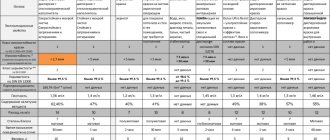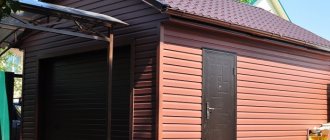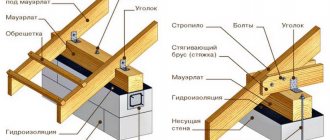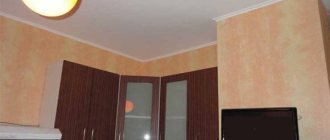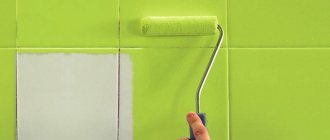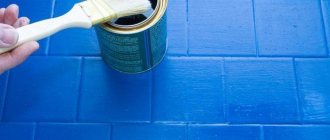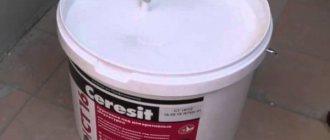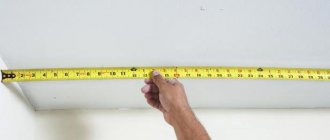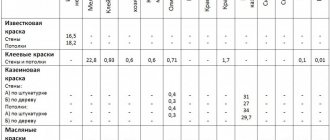Weight of 1 liter (1 dm 3 ) of primer: – deep-penetrating primer Moment Soil – 990-1030 g; – TIEFGRUND KREISEL deep penetration primer – 1020 g; – primer PUTZGRUND 330 KREISEL for mineral, acrylic and mosaic plaster – 1500 g; – primer paint Ceresit CT 16 – 1500 g; – dispersion primer for absorbent mineral substrates Thomsit R 777 – 1000 g; – primer Ceresit CT 14 – 840 g; – emulsion Ceresit CP 41 – 1000 g; – primer paint Ceresit CT 15 silicone – 1500 g; – primer Thomsit R 762 – 1000 g; – primer Thomsit R 766 – 1050 g.
Random entries - how much does it weigh:
Permission is granted to reprint and distribute materials from this site with a direct indexed link.
Knowing the specific consumption of primer, you can easily create an estimate for repair costs. Priming, although invisible in the end, is an extremely important step in any finishing work. And no matter what kind of work they do, be it wallpapering, plastering, tile gluing, puttying, painting - before performing any of the above work, it is imperative to prime the walls. Of course, for some reasons, it is necessary to know the primer consumption per 1 m2 of wall - without this it is impossible to make a correct estimate and not to know what funds will be needed for this. and no one wants to buy a primer beyond what is necessary.
How many liters are in 1 kg of peat?
In its natural state, it has a high gas and water absorption capacity (1 kg of such peat can absorb up to 10 liters of water).
Interesting materials:
How deep should tomatoes be planted? How to correctly arrange sockets? How are we going out for the November holidays 2022? How and with what to wash windows? How and why to take flax seeds? How and for how long to stand in the plank? What is the best way to store apples? How and when are maternity benefits paid? How is property divided during a divorce? How to play on iPhone using PS4 joystick?
Primer consumption per 1m2: what are the standards?
The question of what is the consumption of soil per 1m2, for example, of a wall, cannot be answered unequivocally - such an answer simply does not exist. Let's try to figure out why.
An indispensable component of the characteristics of this material is the consumption rate per 1 m 2, which must strictly comply with GOST.
The fact is that this parameter, like soil consumption, is not a specific, completely accurate figure for all types of primer - this indicator is very dependent on the different types of this material.
Consumption depends on both the type of primer and the type of surface being primed
Primer consumption per 1 m² of wall (video)
In conclusion, I would like to draw the consumer’s attention to some things that simply cannot be kept silent about. If you have any doubts about what you think they are telling you to buy, more primer, don’t rush to do it. It’s better to buy more later than to “stock up” for future use until the next major renovation of your home. Any material – and soil is no exception – has its own shelf life. And one more thing: do not forget about safety precautions when carrying out priming work. Wear gloves, a respirator and safety glasses. Keep the soil away from children. Take care of yourself and your loved ones!
Volume of cans. How much does water weigh in a jar?
How to convert from grams to milliliters, from kilograms to liters, from milliliters to milligrams? Simple table.
- Conversion table from Liters to Cubic Centimeters
- Find what the fraction two thirds 2/3 is equal to
- see also
- Convert units: liter [l] to cubic cm [cm³]
- Convert liters to kg – online calculator
- Updates to convert liquid from liters to kilograms:
- How many grams are in 1 liter of water?
- Need to convert from grams to milliliters? Know what exactly you are translating!
- Half-liter jar (500 ml)
- Physics calculators
- Volume units
- Cubic meter
- Liter
- Jill
- Dram
- Math calculators
- Measurement of physical quantities
Conversion table from Liters to Cubic Centimeters
| How many kg are in 1 liter of solvent 646 - a liter jar. | We use reference data on density and specific gravity, calculating using the formula to obtain the volumetric weight. | 0.80 | Directory of physical properties, GOST, TU. | Liter jar. | up to 5% | — |
| Liter | 1 | 5 | 10 | 25 | 50 | 100 | 250 | 500 |
| Cubic centimeter | 1 000 | 5 000 | 10 000 | 25 000 | 50 000 | 100 000 | 250 000 | 500 000 |
Find what the fraction two thirds 2/3 is equal toRating: 3.4 (52 votes) see also | Comparison of fractions | Interest | Converters | |
| Numbers | Percent to Fraction | Fraction conversion | Profitability of pizza | Fractions |
Convert units: liter [l] to cubic cm [cm³]
1 liter [l] = 1000 cc [cm³]
Measuring cup with milk
Convert liters to kg – online calculator
Converting liters to kilograms can be done using the formula:
M = V * p
p – liquid density
Updates to convert liquid from liters to kilograms:
05/27/2019 – Motor oil
How many grams are in 1 liter of water?
1 liter equals 1000 grams
Important! For clean water at normal atmospheric pressure (760 mm Hg) and the temperature of the highest water density (+3.98 °C).
Need to convert from grams to milliliters? Know what exactly you are translating!
To convert from grams to milliliters or vice versa, you need to know the substance for which you are counting. Not all substances in the world were created equal, some are lighter than others. For example, corn syrup is heavy; 1 ml of syrup weighs approximately 1.5 grams. And flour is light, 1 ml of flour weighs only 0.4 grams. But there are substances that are even heavier than corn syrup and lighter than flour.
Does this mean that converting from grams to milliliters is too difficult? No, that doesn't mean it! Read on.
Half-liter jar (500 ml)
A half-liter jar should be filled exactly to the rim - this corresponds to a volume of 500 ml or a water weight of 500 grams.
The rim is marked with a red stripe in the image, look carefully - sometimes it can be confused with other lines present on the neck of the jar.
Click on the picture to enlarge the image and take a closer look at the marked border.
Primers (acrylic penetrating)
Scope of application (purpose).
Recommended for priming finely porous, highly absorbent bases containing sand (any kind of plasters), gypsum and plasterboard slabs, sand-lime bricks, ordinary bricks and iron ore, asbestos cement, foam concrete, for strengthening slightly dirty, chalking, but firmly held coatings.
- Strengthens weak, loose and crumbling surfaces on the façade and indoors.
- Prevents the growth of bacteria, fungi, mold.
- Protects against blue staining and rotting.
- Effectively protects treated surfaces from dampness.
- Suitable for all types of coatings, including water-dispersion paints, enamels, alkyd, oil paints, parquet varnishes, marble chips, structural plaster, etc.
It can be used as an additive to dry mixtures (plasters, putties, grouts, etc.) to improve their properties. Does not contain volatile toxic components. Using a primer reduces paint consumption, reducing the cost of painting work.
Basic properties of the Primer
Deep-penetrating primer (loose substrates up to 10 cm), based on pure acrylates, with very high adhesive ability (cements crumbling and loose surfaces), quick-drying.
- Does not contain solvents.
- Significantly improves adhesion (adhesion of subsequently applied materials to the surface).
- Gas-permeable (does not isolate water vapor indoors, the surface “breathes”).
- Does not have a harmful effect on the environment, diluted with water, odorless.
Specifications.
Matte Oud. weight:
1.01 kg/l, proportion of dry substances 10 - 12% Application temperature: not lower than 5°C for the environment and substrate, ideal application at a temperature of approximately 20°C Average consumption: 1 l per 8-10 sq.m. single layer coating. The exact consumption is determined by a test coating (depending on the type and structure of the base). Drying time: After 1-2 hours you can apply paint. Cleaning of tools: Rinse tools with water immediately after use. Storage: Store in a tightly closed container, in a dry and cool place (storage temperature from 5°C to 25°C). Do not freeze! Measures
Safety: Keep away from children! Do not discharge into sewers or bodies of water. In case of contact with eyes, rinse with water.
Method of application (application).
Tools – brush, roller, spray (also without air).
Preparation of the base – The base must be clean, hard, dry and strong. Remove release agents (chalk, lime), oil and flaking coatings thoroughly. If the bases contain loose sand or are porous, then it is recommended to work without dilution, according to the “wet in wet” principle, until the surface is completely saturated and the primer has hardened. On more durable bases, apply soil diluted with water, taking into account the characteristics of the base, but the addition of water should not exceed 30%. A trial application of the primer to the surface is necessary to determine the required degree of dilution, since the structure and absorbency of surfaces are different. When processing plasterboard sheets, it is enough to apply 1 layer of primer.
Assortment of Acrylic primers.
- Primer Optimist (Russia) – for interior and exterior work (blue and yellow label) with special antiseptic additives. Containers 1, 5, 10 l.
- Acrylic primer TEKS (Russia) – for interior and exterior work with a high concentration of acrylic component and special antibacterial additives. Container: 5, 10 l.
- Primer Tiefgrund (Russia - Germany) acrylic deeply penetrating primer - for treating finely porous and hygroscopic surfaces. The product, manufactured according to the European standard DIN 55947, is tested and recommended for use in the KNAUF construction system - processing of plasterboard sheets. Container: 1, 5, 10 l.
- Primer Betokontakt (Russia-Germany) acrylic primer with increased adhesion. It is mainly used for non-absorbent or weakly absorbent surfaces, such as dense concrete, ceramics, ceramic tiles - for further painting, tiling and other work. Container: 5, 7 l.
This assortment reflects the most popular and sought-after brands among professional builders and private buyers who carry out repairs on their own. price-quality ratio for these materials.
- Savings (reduced paint consumption when painting an already primed surface due to an even film and uniform application of paint).
- Speed of finishing work (due to quick drying and better adhesion of materials).
- Surface durability (good adhesion and separation of acidic and alkaline environments, antifungal protection).
- Strength due to additional fastening of old and crumbling surfaces.
- Environmental safety and manufacturability of the material (acrylic components do not have an unpleasant odor, are not harmful to health, dilution and cleaning of tools with plain water, and not with special solvents).
Go to the “Sealants” section in the “Electronic Store” for a more detailed description of the product >>>
Calculation of paint weight
To find out how much weight there is in a liter of material, you will have to take a physics course. There is a density formula that takes into account volume and mass:
p=m/V
Here m represents mass, V is volume, p is density. Typically the density does not exceed 1.2-1.6. It is always indicated on the packaging of the paint and varnish material in the “technical characteristics” section. By converting the formula to m = V x p, taking the density and volume indicators (1 liter or other figure), you can easily calculate how many kilograms this jar weighs.
Since the density of paint is always greater than that of water-based liquids, the weight of a standard can will be higher than 1 kg - usually 1.08-1.44 kg. You can then use this information to determine the overall severity of the required dye.
Specific gravity of primer, weight of 1 liter of primer, table of values
The primer is a cold bitumen type primer. It is called cold due to the fact that it does not require heating, other preparation or preparation. That is, it is initially in a suitable condition for work. There are exceptions to this rule, such as “Primer Concentrate,” but such types are very rare. Most often, you can find a ready-made product for the required use in construction work, without the need to add anything or dilute it.
This building material is most often used to construct a roofing carpet, namely as a primer when creating a base. That is, the primer serves as a coating for the screed before laying roll-type roofing materials.
This approach not only ensures dust removal from the surface, but also increases the adhesion of the roof to the base, and also serves as a means for leveling the coating, penetrating into small cracks and micropores. Thus providing more reliable waterproofing and increasing the life of the materials.
The name itself comes from the English word “Priming”, which in translation sounds like “Primer”.
Weight of different compounds
It should be remembered that the measurements taken may be inaccurate, because sometimes the density varies by a fraction of a percent. But the error rarely exceeds 5%, which is insignificant for domestic purposes. Laboratories that require precise calculations carry out their density measurements using special equipment. This allows you to obtain results with virtually no error.
Below is a table of the densities of individual types of paints. The limits of permissible values are indicated, which vary from one manufacturer to another:
| Type of paint | Density, kg/m3 |
| Water-based | 1,34-1,36 |
| Latex | 1,5-1,58 |
| Pentaphthalic enamels | 0,9-0,92 |
| Acrylic | 1,45-1,55 |
| Primer GF | 1,49-1,52 |
| Silicone | 1,39-1,4 |
Calculating the weight of paint can provide useful information. To carry out the calculations, you just need to read the attached data or find them on the manufacturer’s website.
How many layers of primer should be applied to the walls: let’s clarify the situation
In most known cases, we are talking about two layers of primer.
The number of primer layers applied to the walls largely depends on the further nature of the finishing work:
- Plaster;
- Gluing tiles;
- Putty;
- Wallpapering;
- Application of decorative plaster, etc.
However, that's not all.
The number of primer layers will vary depending on further work and the porosity of the base
Two more significant factors must be taken into account:
- Base porosity;
- Substrate moisture.
In addition, after drying the primer, you should run your palm over the primed surface, and if your palm does not get dirty, and there are no particles of plaster or putty left on it, there is no particular need to apply a second layer of primer.
And one more nuance, and this concerns the preparation of the base for porcelain stoneware. Here, of course, you cannot limit yourself to just one layer of deep penetration soil. In addition to such priming of the base, a primer with glue is also necessary in order to fill small cracks and increase the area of contact with the base.
Primer GF-021 gray GOST 25129-82
Table 1. How many kg are in 1 liter of primer. Liter standards. A measuring tool for determination without scales is a liter jar. How much is the volumetric weight of the primer in one liter - kg/liter, at its normal density under normal conditions, the quality, chemical composition and physical properties are declared in GOST, correspond to the manufacturer's specifications.
Comments, interesting explanations on the question “how much does a liter volume weigh” and some additional information on reference data on physical properties.
We actually have 1 liter of primer, a liter jar or a certain amount known in liters, we want to find out the mass: how much does it weigh in kg or grams. That is, our task is to determine how much it weighs: recalculate liters of primer - units of measurement of volume into kilograms - units of measurement of the weight of the primer. Having determined the volumetric mass of 1 liter of primer, how much in kilograms, without weighing on a scale. Find out how much it weighs (for example: a liter jar), based on calculated, theoretical, reference data from the table of physical properties: specific gravity and primer density. It is better, of course, not to use the true density, but the bulk density, if you can find the bulk density in the reference book. Which is actually not so easy to do in practice. It is extremely inconvenient to independently recalculate based on physical properties, also because most tables, GOSTs, TUs give values of specific gravity and density “tied” not to a liter jar, but in other units: tons/m3, kg/m3, kg/cube, g/cm3. If you wish, you can spend a lot of time, find data, perform the recalculation yourself and find out how many kg there will be in a liter volume. However, this option to find out how much a liter volume weighs is not a simple and convenient way for everyone, especially since it requires searching for additional information on the bulk density of the primer and its specific gravity, plus knowledge of the conversion formula. Therefore, we ourselves made such a recalculation based on the physical properties given in GOST and TU, indicated the mass of 1 liter of primer in kg, a liter jar, giving it in a separate table of weights and volumes. An extract from the general table is given above. Question: how many kg are in one liter of primer, liter volume. Answer: see bulk density in Table 1. How to find out how much it weighs - measure the mass of the primer with a liter jar, independently, without weighing it on a scale. On our website you can find other interesting practical information on density and specific gravity not listed in conventional reference books, tables, GOSTs and specifications, which is not so easy to find on the Internet. For example, for the more familiar units of volume: cm3, m3, cube, cubic meter, cubic meter. Household and cutlery measuring products: teaspoon, tablespoon, glass. More construction, gardening, manufacturing and industrial: shovels (bayonet and scoop), packs, buckets, bags, pallets, barrels, construction or garden wheelbarrows. Transport: tank car, railway tank, railway car, on-board vehicle, truck, dump truck. These are so-called non-standard containers, often used in practice. Despite all the variety of containers, each of them has its own displacement. This means that it is possible to recalculate the mass of the load in kg using the values indicated in Table 1. Naturally, this technique has its own errors. In this case, the error in calculating the mass of a large displacement will be higher than the error in determining the mass of a liter volume indicated in Table 1.
Bitumen primer: consumption per 1m2
Since bitumen primer is in demand in construction, of course, the consumer is interested in knowing what its consumption rates are.
Bitumen primer is perfect for treating concrete, brick and bitumen roll materials.
Average consumption rates for bitumen primer are 0.3-0.5 kg/m2.
The only exceptions are some brands, for example, Transkor-Gaz, which is widely used in the re-insulation of gas and oil pipelines. Its consumption rate is 80-100 g/m2.
Bitumen primer is widely used in construction, mainly for waterproofing
Of course, in order to meet this limit provided by GOST, you need to take into account what else this important indicator depends on.
It depends:
- From the surface on which this coating is intended to be applied. It must be free of dust and dirt, and must also be dry.
- From the choice of tool for applying the primer: it can be a brush, roller, roofing brush, spray bottle. These tools “consume” the soil differently.
- Highly porous surfaces require at least a second coat of primer.
